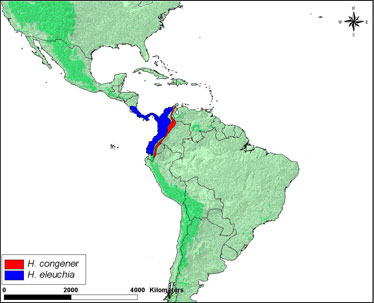Heliconius congener
Margarita Beltrán and Andrew V. Z. BrowerIntroduction
A member of the sapho clade occurring on the Amazonian slope of the Andes from Colombia to Northern Peru. H. congener is involved in Müllerian mimicry with H. sara, H. leucadia and H. wallacei.
Characteristics
Early stages: Eggs are yellow or white and approximately 1x 0.7 mm (h x w). Females usually place 5 to 40 eggs on growing shoots of the host plant. Mature larvae have a yellow body, with black scoli and head; length is around 0.3 cm. Caterpillars are gregarious (Brown, 1981).
Adult: H. congener forms are black with yellow transverse forewing stripes, the bases of the dorsal wing surfaces being clothed in dark blue iridescent scales. Specimens of this species are most easily discriminated from similar-looking H. sara forms by the pattern of red spots/streaks on the ventral hindwing base. In H. sara there is a row of red spots along the anal margin of the hindwing, while in H. congener, the spots are confined to the wing base in a pattern reminiscent of that on H. sapho.
Geographical Distribution
Heliconius congener is distributed in the North of the Andes. This map shows an approximate representation of the geographic distribution of this species. The original data used to draw these maps are derived from Brown (1979) which is available at Keith S. Brown Jr. (1979). Ecological Geography and Evolution in Neotropical Forests.
Habits
H. congener occurs from 600 to 2,000 m in montane forest. Usually individuals fly slowly and in the canopy. The males sit on female pupae a day before emergence, and mating occurs the next morning, before the female has completely eclosed. Adults roost at night in large groups on twigs or tendrils over water (Brown, 1981).
Host plant: H. congener larvae feed primarily on plants from the genus Passiflora, subgenus Astrophea (Brown, 1981).
References
Brown, K. S., Jr. 1979 Ecologia Geográfica e Evolução nas Florestas Neotropicais. Campinas, São Paulo, Brasil: Universidade Estadual de Campinas.
Brown K. S. 1981 The Biology of Heliconius and Related Genera. Annual Review of Entomology 26, 427-456.
Lamas, G. (ed.) 2004 Atlas of Neotropical Lepidoptera. Checklist: Part 4A Hesperioidea - Papiionoidea. Gainesville: Scientific Publishers/Association of Tropical Lepidoptera.
Weymer G, Maassen P. J. 1890. Lepidopteren gesammelt auf einer Reise durch Colombia, Ecuador, Perú, Brasilien, Argentinien und Bolivien in den Jahren 1868-1877 von Alphons Stübel. Berlin, A. Asher & Co. [1] , xi , 182 pp., 9 pls.
Title Illustrations

| Scientific Name | Heliconius congener congener |
|---|---|
| Specimen Condition | Dead Specimen |
| View | Dorsal |
| Collection | Gerardo Lamas |
| Image Use |
 This media file is licensed under the Creative Commons Attribution-NonCommercial-ShareAlike License - Version 3.0. This media file is licensed under the Creative Commons Attribution-NonCommercial-ShareAlike License - Version 3.0.
|
| Copyright |
©

|
| Scientific Name | Heliconius congener congener |
|---|---|
| Specimen Condition | Dead Specimen |
| View | Ventral |
| Collection | Gerardo Lamas |
| Image Use |
 This media file is licensed under the Creative Commons Attribution-NonCommercial-ShareAlike License - Version 3.0. This media file is licensed under the Creative Commons Attribution-NonCommercial-ShareAlike License - Version 3.0.
|
| Copyright |
©

|
About This Page

University of Cambridge, Cambridge, UK

Middle Tennessee State University, Murfreesboro, Tennessee, USA
Correspondence regarding this page should be directed to Margarita Beltrán at and Andrew V. Z. Brower at
Page copyright © 2010 and
 Page: Tree of Life
Heliconius congener .
Authored by
Margarita Beltrán and Andrew V. Z. Brower.
The TEXT of this page is licensed under the
Creative Commons Attribution-NonCommercial-ShareAlike License - Version 3.0. Note that images and other media
featured on this page are each governed by their own license, and they may or may not be available
for reuse. Click on an image or a media link to access the media data window, which provides the
relevant licensing information. For the general terms and conditions of ToL material reuse and
redistribution, please see the Tree of Life Copyright
Policies.
Page: Tree of Life
Heliconius congener .
Authored by
Margarita Beltrán and Andrew V. Z. Brower.
The TEXT of this page is licensed under the
Creative Commons Attribution-NonCommercial-ShareAlike License - Version 3.0. Note that images and other media
featured on this page are each governed by their own license, and they may or may not be available
for reuse. Click on an image or a media link to access the media data window, which provides the
relevant licensing information. For the general terms and conditions of ToL material reuse and
redistribution, please see the Tree of Life Copyright
Policies.
- First online 18 February 2007
- Content changed 13 August 2008
Citing this page:
Beltrán, Margarita and Andrew V. Z. Brower. 2008. Heliconius congener . Version 13 August 2008 (under construction). http://tolweb.org/Heliconius_congener/72939/2008.08.13 in The Tree of Life Web Project, http://tolweb.org/







 Go to quick links
Go to quick search
Go to navigation for this section of the ToL site
Go to detailed links for the ToL site
Go to quick links
Go to quick search
Go to navigation for this section of the ToL site
Go to detailed links for the ToL site